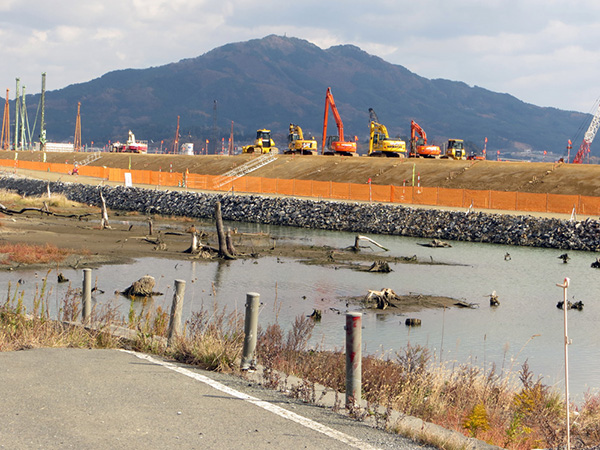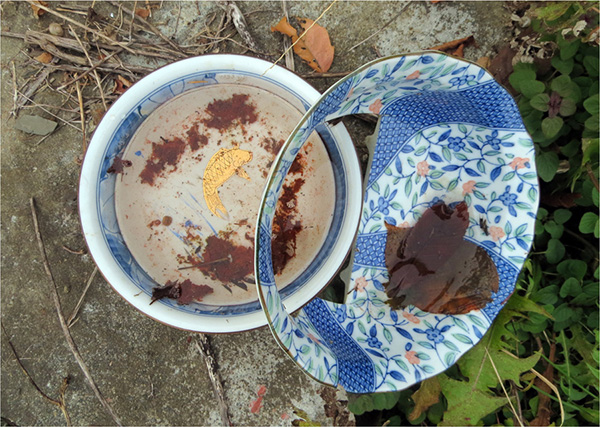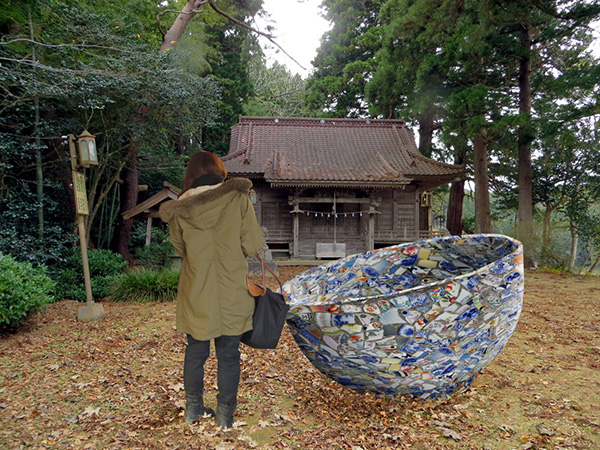

Cornelia Konrads (Artist)
In short, landscape is the link between our outer and inner selves.
Bill Viola, Reasons for Knocking at an Empty House, Writings, p.253
How I encounter “my site”
As a passionate traveller and site specific sculptor, I had the chance to stay and work in various countries all over the world. Mostly (and preferably) I go on a travel without a predefined plan. Starting point after arrival is always: walking. Meandering in an unknown area, in search of the site and the form of a work, I collect what lies on the edge of my path: shapes, materials, local habits and occurrences.
All my works are deeply connected with the place where i build them. I see the site not as a background, but as a texture. The goal is, that my work becomes a part of this texture.

jardin en movement. 4 x 4 x 1.2 m . stones, cement, iron . Installation around a bended cork oak
Domaine du Rayol – Jardin des Méditerranées, Rayol-Canadel-Sur-Mer (France) 2014
So I’m looking for the smell and the sound of a place as well as for its stories and memories. Meanwhile I know, that those walks will bring me into a close dialogue with the place, reflecting about the landscape, architecture, vegetation and history of the surrounding area. I can rely on the fact, that sooner or later my excursions will bring me to „my site“, a spot where all thoughts and impressions condensate to an image, an idea, a project.
This process of searching and finding, as i experienced it in the context of residencies, commissions and exhibitions, is of course every time exciting and special. Nevertheless it happened in my recent projects, that I sometimes feel a kind of “routine” I would like to avoid.
Is art possible here?
Walking in Rikuzentakata I realized, that before I had worked in most cases in rather protected areas, where artwork was previewed and my role as an artist clearly defined – places like parks, forests, gardens: places created to spend a leisure time, to enjoy beauty – a beauty, I often see threatened, which I refer to in my work.
At first sight nothing was beautifull in Rikuzentakata – I have to say honestly, that I was shocked in the beginning: I moved through a wounded landscape full of pain, not only devastated by the first “natural” Tsunami, but also by the technical interventions to reconstruct the town. I saw giant machinery erasing and transforming parts of the landscape: mountains, forests, beaches. It appeared to me allmost like a second “artificial” Tsunami, a violent act of human revenge in the war against nature. The carefull aquaintance with nature, I’ve often sensed in japanese philosophy and traditions, I couldn’t find here.

Rikuzentakata – construction area
Encounters with people who changed me
In this first days I was often wondering about the purpose of this visit and my role as an artist: is art possible here? Does it make sense? And how could I contribute, or respond – as a stranger from far away, landing in the middle of a disaster zone, with the protection of a flightback- ticket in the pocket?
A crucial change for me came with the local people, I met.
I was enchanted by the people of Rikuzentakata: their curiosity, humour and kindness, their will to share their stories and memories, their courage to start again after all the sadness they went through, their power to create something from nothing, their dignity. Very soon i didn’t feel as a stranger any more – not even as an artist! Just as a witness.
This refers to another new and exceptional aspect of this residency: The focus was not to work on my own on a singular project – but rather to work together, take part in social life, meet people!

Meeting residents of a temporary settlement
I discovered the beauty of the people, specially the old ones. I also found their marks and traces in the landscape: carefully arranged memorials, collections of lost and broken things, someone had picked up and stored thoughtfully. It suddenly brought back to my mind a Haiku of Matsuo Basho, i had read many years ago:
よくみれば 薺はなさく 垣ねかな
(Looking carefully – a Shepherd’s Purse is blooming under the fence. by Basho Matsuo)
“Looking for the Shepherd’s Purse” became a theme for me, and the following walks I did with my camera and Matsuo Basho’s request in my mind: Look carefully! Pay attention to the small gestures and simple signs of life! They are just by the feet, easy to overlook – but once discovered they imply a lesson. Like the “Shepherd’s Purse”. And like the people I met in Rikuzentakata.
The first result of my search was a photo series, showing situations where the spirit of the “Shepherd’s Purse” was present for me. The motives of this series have in common, that they are ephemeral, soon they will disappear or change. By documenting them I found a role and a task which made sense for me: to keep the memory of this places in transition; to be a kind of “creative witness”.

From the photo series “Shepherd’s Purse”
I just “followed my nose” during this walks, and it often led me to a certain area leftside/upstream Kesenriver, a spot where the traces of the Tsunami are still visible.

Tsunami traces
A borderline between the forest on top and lower vegetation on the bottom of the surrounding hills showed the height of the wave, and it sometimes seemed, as if its echoe was still hanging in the air. Yet the bulldozers didn’t enter this area, though they were coming closer every day. Faded fotos, small memorials, a carefully planted garden showed the attempts of people to cope with the disaster. This was for me the area, where the „Shepherd’s Purse“ was blooming frequently.

Remains of a small memorial garden
Picking up broken pieces and joining them to stories and memories
Circling around a small temple on top of a hill – a peacefull place, i liked very much and often took as starting point – I noticed that the ground was strewn with pieces of broken china – like shells on the beach. Some halfburied in the earth, some shining in the sun. Obviously the wave had smashed countless bowls and plates and scattered the fragments all around. It brought me to the idea to reconnect all this fragments in the way of a mosaic, and in shape of a large bowl or coulumn.

Project proposal mosaic-bowl (photomontage)
With the help of my collegues, I collected two big boxes full of broken china.
Walking and collecting in this area, where the past was still so present, was surely a special experience for each of us.

Collecting pieces of broken china
Later I cleaned piece by piece and stored them in a safe place. To collect, clean and join them means for me: to keep the stories and memories – in a certain way to help create history.
For the future I hope, that a permanent site will be found, once things are more settled in Rikuzentakata, and that I can return and realize a mosaic sculpture there – if possible as a collaborative work with local people.
So the Rikuzentakata Residency Program started with some doubts and questions for me – and it ended with the wish to come back and continue. I’m very gratefull, that its target is defined as “research”, and not as “completion of a work”, as it is often expected in the context of other artist residencies. This subject allowed me to face my doubts and questions, which are in fact essential for an artist, and should be faced sometimes.
Now, looking back and resuming, I think that the experiences I made in Rikuzentakata are incomparably rich and fruitfull – probably because of the difficult start, and surely because I really “touched the ground” there – literally and mentally.
A basic condition of course – and the special chance and challenge of this residency – is that it is located far away from the routines and attitudes of „art-world“, and that it is focused on an open research: to explore and build bridges between people beyond the limits of language and culture, between past and future and between inner and outer landscapes.
Residency Period: November 15 – Devember 8, 2014

Cornelia Konrads
Born 1957 in Wuppertal/Germany
Studies: Philosophy, Literature and Cultural Science
Freelance artist since 1998, Focus on Site-Specific Sculpture and Objects
Participation in various Sculpture- and Land Art projects in Australia, Asia, Africa, America and Europe
Commissioned permanent and temporary works for public spaces, sculpture parks and private collections
Invitations as Artist in Residence to: Odense (Denmark 2001), Ahrenshoop (Germany 2001), Kamiyama (Japan 2005), St. Pierre en Chartreuse (France 2006), Aomori (Japan 2009), Bakersfield (USA 2011), Utica (USA 2012), Serenbe/Atlanta (USA 2013)
[January, 2015]
2024.7.9Acasă la Hundorf Residency JournalArtist : Miyake Suzuko
2023.5.14AIR and I, 09 : Mentoring Artists for Women’s Art (MAWA) Residence Report